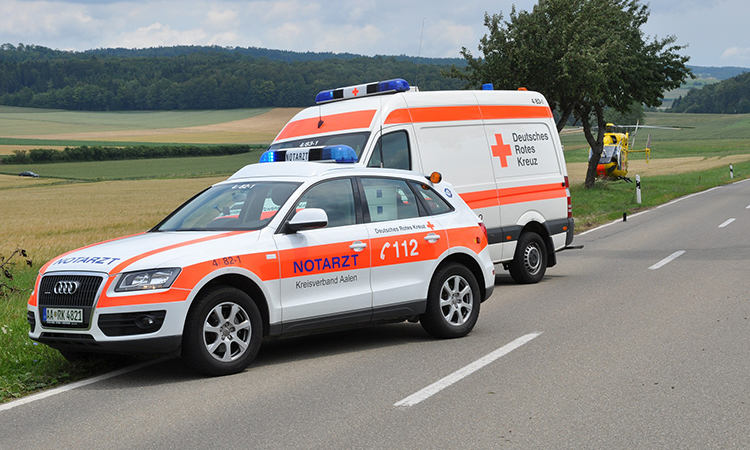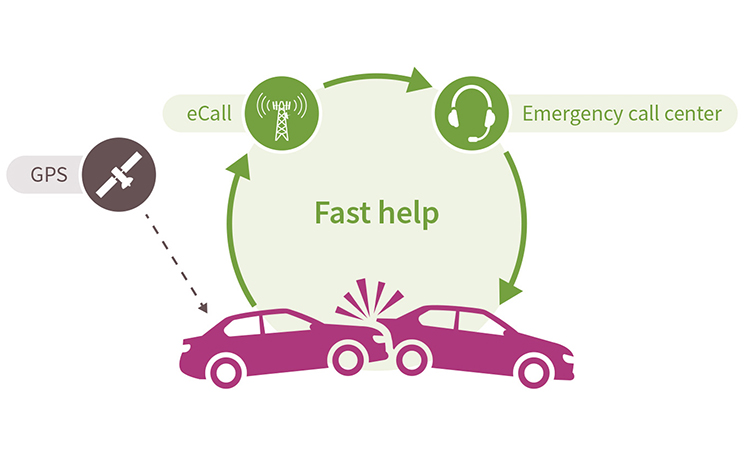From this month, ecall technology is mandatory on new vehicles in the EU. Steve Rogerson looks at what this means for car makers and their suppliers.
The technology has existed for some time that lets a car call the emergency services automatically if it has been in an accident. However, from April this year, it became mandatory for all new cars sold in the European Union (EU) to be fitted with the ecall technology.
This will use a combination of satellite signals to get the vehicle’s exact position, various sensors to provide information to the emergency services on orientation and number of passengers, and the cellular network to make the actual call.
According to the European Commission (EC), this will reduce the response time by up to 40% in urban areas and up to 50% in rural areas. The EC reckons this could cut the number of fatalities on Europe’s roads by ten percent.
The system is activated by the air bag being deployed. It’s also possible to trigger an ecall manually, for example if a driver witnesses a serious accident. According to the European standard, a minimum set of data must be transmitted to the public safety answering point (PSAP). This data telegram is 140bytes long and contains information selected on the basis of relevance in an emergency such as the time, the vehicle type and location, the drive type, the number of passengers, the direction of travel, the way in which the emergency call was triggered, type of fuel, and other information.

There are three main components to an ecall system. The first is the telematics control unit (TCU), also known as IVS, or in-vehicle system.
The first generation systems are not too complex, according to Thomas de Vial, Product Manager at automotive supplier Continental. “The challenge was to integrate the antenna and make the relevant connections in the car,” he said.
It will also need updating during the lifetime of the vehicle using over-the-air transmissions. Part of this is due to security concerns as the IVS is a route to the outside world and it is connected to various systems within the vehicle itself.
Car makers will want to make the most of having to install the equipment to offer other telematics services. One of the easiest is a connection from the vehicle to the car maker for remote diagnostics. It could also be used for pay-as-you-drive insurance and the driver remotely starting the air conditioning or heating.
And as it has to connect to satellite networks, it could be used for navigation and for fleet managers to find the exact location of their vehicles. It could even be used for geofencing for, say, a parent limiting the area in which their children can use the car.
However, none of these extras can affect the primary function of the IVS, which is to make an ecall. “The IVS is in charge of generating the response,” said Francois Ortolan, Wireless and Automotive Specialist at Anritsu.
This creates the minimum set of data that is sent to the emergency services based on information it has collected through the in-vehicle network, usually the Can bus. Sensors around the car gather information such as orientation and passenger numbers and send that over Can to the TCU.
The second component is the cellular network itself. The communications over the network do not use traditional cellular ways of transmitting data but what is known as in-band communications. This is transmitted over the voice channel, because it is given priority over data channels in the network.
As most mobile phone users know, sometimes a text message can be delayed by a few minutes or even longer, and that could be disastrous if it happened to an ecall message.
“Also, regardless of the cellular technology, there will always be voice communications,” said Ortolan. “The method for using data communications might change.”
The same voice network is then used by the emergency services to make a call to the car in the hope that they can speak to someone to gather more information, such as the medical condition of the occupants.

Today, the cellular connection is based on 2G and 3G circuit switched technology. The next generation will use packet switched LTE.
“There is a lot of work going into this technology,” said de Vial. “It is not clear when this will happen, but not before 2023 to 2025. With packet-switched technology, you can enhance the service with video streams from internal cameras so the emergency services can see the extent of the damage and the state of the occupants.”
And Chris Gillis, Applications Engineer at Rohde & Schwarz, added: “LTE is a lot faster, and it doesn’t make sense to send the minimum set of data over voice. With LTE, you can send the data quickly and establish the voice call. They have finished some of the standard for this but not decided when or if it will be mandatory. Some car makers may add this themselves without being mandated.”
What will still be needed with the current technology is for the network operators to increase their coverage. While they mostly have good coverage in towns and cities, it can still be patchy even on some major roads and especially in rural areas. The third component is the PSAP. These have been in place since last year.
Testing
While all car makers have to install ecall modules to a fixed standard, there can be variations in the quality of components that they choose.
“This can happen within the same car manufacturer depending on the quality of the car,” said Ortolan. “The only testing is the functionality of the device. Every car maker will implement its own flavor.”
However, it is estimated that the technology as it is now will add about €100 to €200 to the cost of an average vehicle.
The main component that needs testing is the modem. Standards body Etsi has defined a set of conformance tests to make sure the modem behaves properly. The testing also has to verify the functionality of the ecall, and the audio quality for the call back.
“One problem is that automotive companies generally do not have experience with RF,” said Gillis. “They have to learn that it is a little bit of a new area for them. They are trying to hire people with knowledge in that area, but they are also learning from us and we are learning from them.”
Part of that for test equipment makers such as Rohde & Schwarz, he said, was to make sure all the features were implemented on the test equipment to make it easier for them to use.
“They typically want something simple,” he said, “that tells them if it is a pass or fail.”
One of the most important tests is the crash test. A car fitted with ecall is deliberately crashed and a network simulator imitates the ecall network. This is done so the testing can take place without making real calls to the emergency services.
“You have to make sure the ecall system can survive a crash,” said de Vial. “In case of an accident, the unit should either still be powered by the main system or a back-up battery in the unit itself.”
Other ecall systems
Russia already has an ecall system in place that uses the Glonass satellite network. In China, the government is looking at how it could be done. There is a private system called Help Net being considered in Japan. The UAE and India are also looking at implementing a system.
“There are a lot of countries getting interested in this technology,” said de Vial. “But there are no mandatory plans in the US.” However, GM is offering its own technology in the US through its OnStar service.
Conclusion
While the mandatory introduction of ecall for new vehicles in Europe is welcome, it will be some time before the majority of the cars on the road will be fitted with the system, though there will be options for it to be installed as an aftermarket extra. However, once its use is widespread, it should contribute massively to the faster deployment of emergency services after an accident. The technology deployment is still in its early stages and there will be teething problems along the way, but at least it is the right way.

